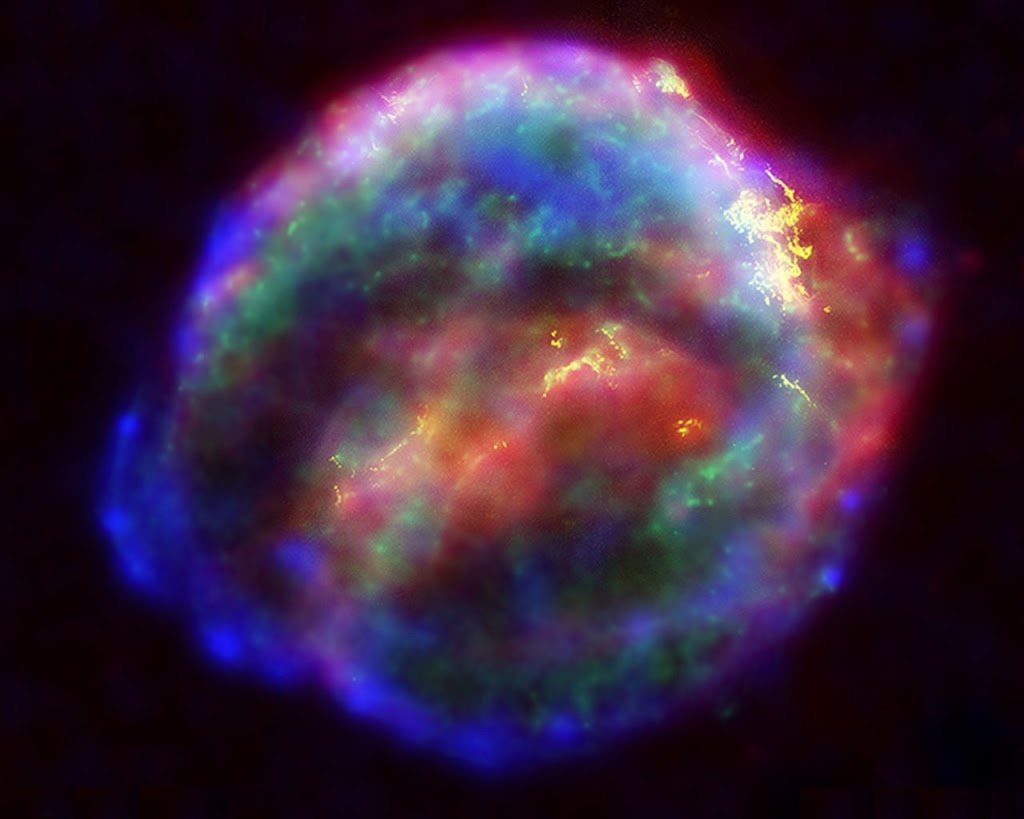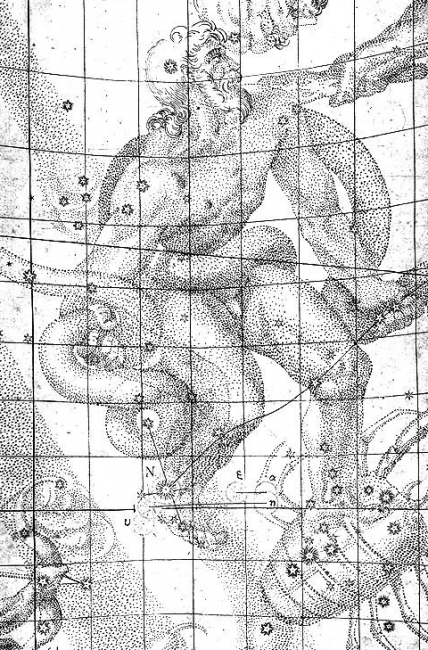
X-ray, Optical and Infrared Composite of Kepler’s Supernova Remnant
On October 17, 1604, the famous German astronomer Johannes Kepler [5] started his observations of the 1604 supernova, named after him as Kepler’s Supernova or Kepler’s Star. Special about this ‘new’ star was it being the very last observed supernova in our own galaxy, the Milky way.
First Sightings
The supernova was first observed on 9 October 1604 by Ilario Altobelli in Verona and Raffaello Gualterotti in Florence, a few days before Kepler really looked at it. And ‘looked at it’ means that he was able to see it with his naked eyes without any telescope. The explosion of the star was so powerful and so bright, that it could be easily detected as one of the brightest objects in the sky for weeks. Getting technical here it is to be said, that SN 1604 had an apparent magnitude of -3, which is a little brighter than Jupiter’s maximum brightness.
On 10 October it was observed by Baldassare Capra, Simon Marius and Camillo Sasso in Padua. Galileo Galilei,[7] then professor at the University of Padua, saw it for the first time on 28 October. Due to the great general interest, he gave three public lectures on the phenomenon. On October 10, the supernova was discovered in China, a few days later in Korea. The Chinese and Korean astronomers left detailed records of their systematic observations over almost a year.
Kepler observed the supernova for the first time on October 17 and, following the occurrence and passing away of the nova, first wrote a short paper in German to explain the phenomenon (Gründtlicher Bericht Von einem ungewohnlichen Newen Stern, 1604-05). Later he wrote a detailed Latin study in the book De Stella nova in pede Serpentarii (“On the New Star in the Foot of the Serpent Bearer“, 1606). His detailed description is also the reason why the object was named after him, although he was not the first to discover it.
From November 1604, the supernova was no longer visible at dusk, and when it was back in the night sky in January 1605, it was still brighter than Antares. It was last observed by Kepler on October 8, 1605, so it was visible for almost exactly one year.
Supernova in General
The 1604 supernova aroused great interest because it coincided with a Great conjunction of Jupiter, Saturn and Mars calculated for October 8, 1604. The supernova was therefore considered by many to be the product of this conjunction. Observations in Italy and Northern Europe suggested, due to the lack of parallax, that, like the supernova of 1572 observed only 32 years earlier, it must be an object beyond the moon. The appearance of another new celestial body beyond the moon’s orbit finally shook the belief in Aristotelian cosmology, according to which the spheres of the planets and fixed stars were unchangeable.
A supernova (from Latin stella nova, super, English ‘new star, beyond’; plural supernovae) is the brief, bright illumination of a massive star at the end of its lifetime by an explosion in which the original star itself is destroyed. The luminosity of the star increases millions to billions of times, for a short time it becomes as bright as an entire galaxy. As you may might know, the brightness (as viewed from Earth) of a supernova is dependent on the mass of the original star, its distance from Earth and many other determinants. Information on the energy, released during the explosion give the supernova remnants and in the case of SN 1604, scientists around the globe are still researching on these matters, trying to find out what really happened during the explosion.

Johannes Kepler’s original drawing from De Stella Nova (1606) depicting the location of the stella nova, marked with an N (8 grid squares down, 4 over from the left)
The Secrets of SN 1604
In 1941, the 100-inch telescope of the Mount Wilson Observatory [8] discovered a weak nebula with a brightness of about 19 mag at the expected location, which is the remnant of the supernova of 1604. Only a few filaments can be seen in visible light, but the supernova remnant is a strong radio source. The diameter is about 4 arc minutes. The distance of the object is not exactly known and is between 3 and more than 7 kpc (10,000 to 23,000 light years) depending on the model used.
Researchers at NASA questioned the known facts on the supernova’s remnant and worked out some untypical behavior using the Chandra X-ray Observatory. In the above picture you can see the X-ray images of the remnant, each color depicting different types of energy. According to these images, they previously concluded the supernova to be ‘Type 1a’, which usually appears after a white dwarf gains mass until becoming instable and is destroyed. So far so good, but very unusual here for this type of supernova is, that SN 1604’s remnant is strongly asymmetrical. Through further studies of these interesting aspects, the researchers came thus to the conclusion that this supernova explosion was a lot more powerful and occurred at a much longer distance than previously assumed, the complete results are described in the September 1st, 2012 edition of The Astrophysical Journal.[6]
But even though huge approaches in these fields of study have been achieved in the last years, not every detail of the event that occurred more than 400 years ago was exposed.
The Lives of Stars – Professor Carolin Crawford, [4]
References and Further Reading:
- [1] Was Kepler’s Supernova Unusually Powerful? at NASA
- [2] The Unusually Colossal Kepler Supernova
- [3] SN 1604 at Wikidata
- [4] The Lives of Stars – Professor Carolin Crawford, Gresham College @ youtube
- [5] And Kepler Has His Own Opera – Kepler’s 3rd Planetary Law, SciHi Blog
- [6] Daniel J. Patnaude, Carles Badenes, Sangwook Park, and J. Martin Laming, The Origin of Kepler’s Supernova Remnant, in The Astrophysical Journal, Vol. 756, No 1, 2012 September 1
- [7] Galileo Galilei and his Telescope, SciHi Blog
- [8] The Hale Telescope at Palomar Observatory, SciHi Blog
- [9] W. Baade: Nova Ophiuchi of 1604 as a Supernova. The Astrophysical Journal, 97, S. 119–127 (1943)
- [10] M. Turatto, S. Benetti, L. Zampieri, W. Shea (Hrsg.): 1604–2004: Supernovae as Cosmological Lighthouses (= ASP Conference Series. Band 342). San Francisco 2005
- [11] Timeline of Supernovae via Wikidata





